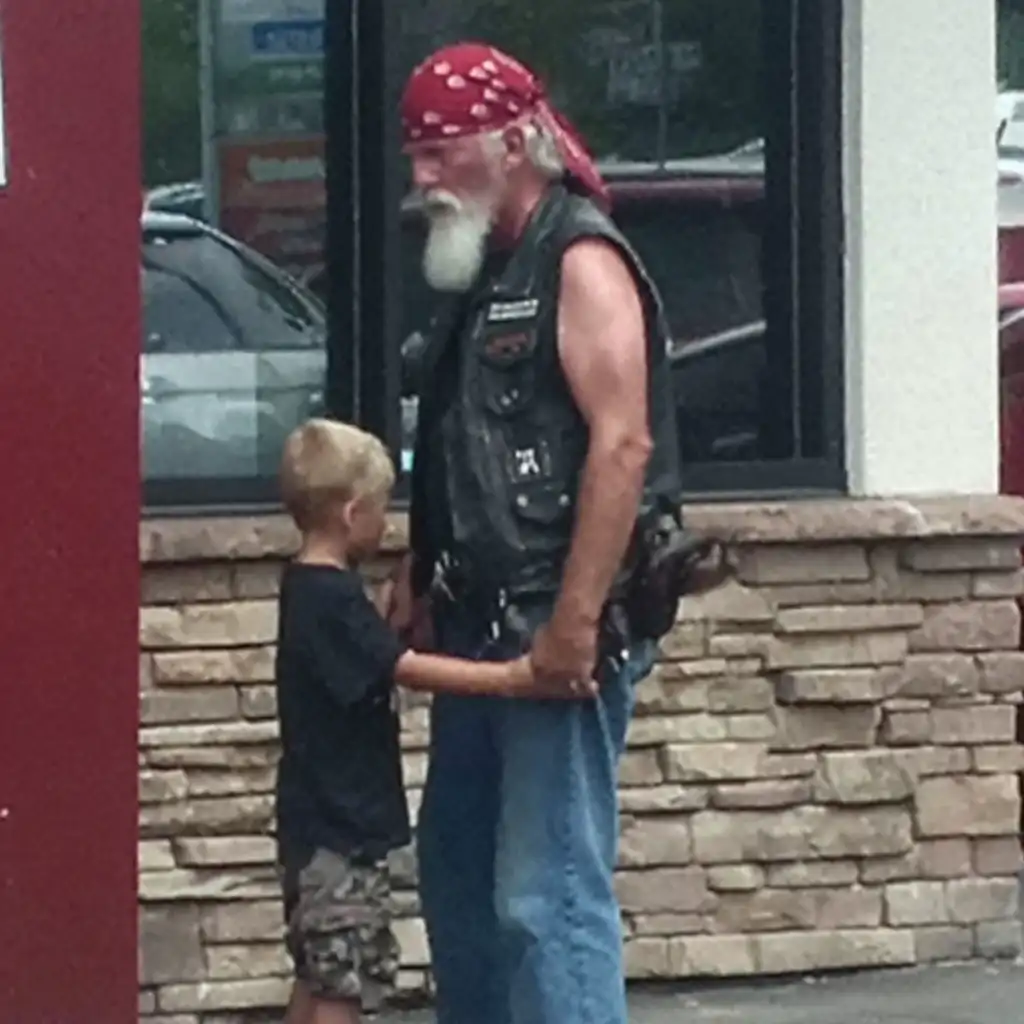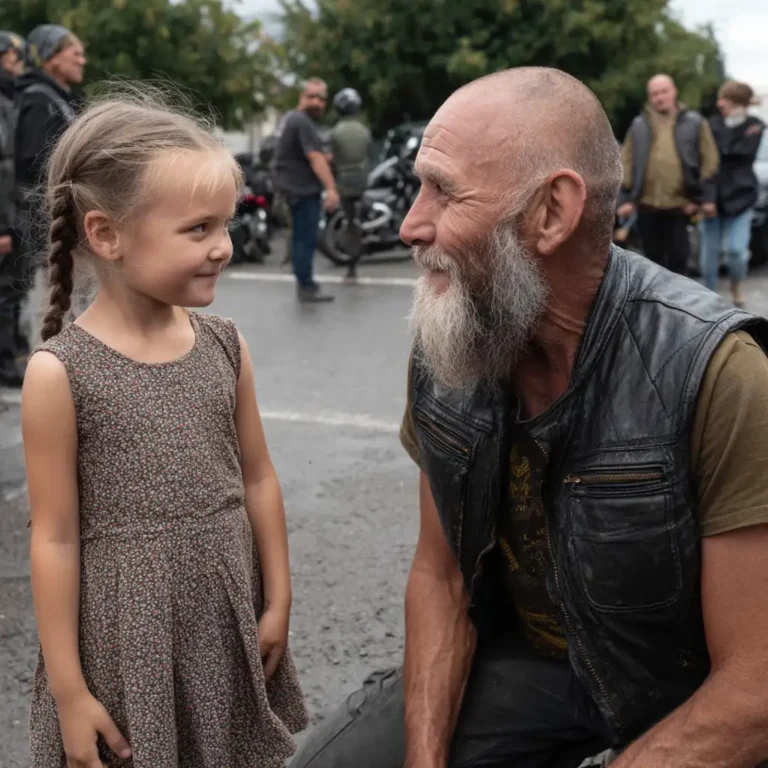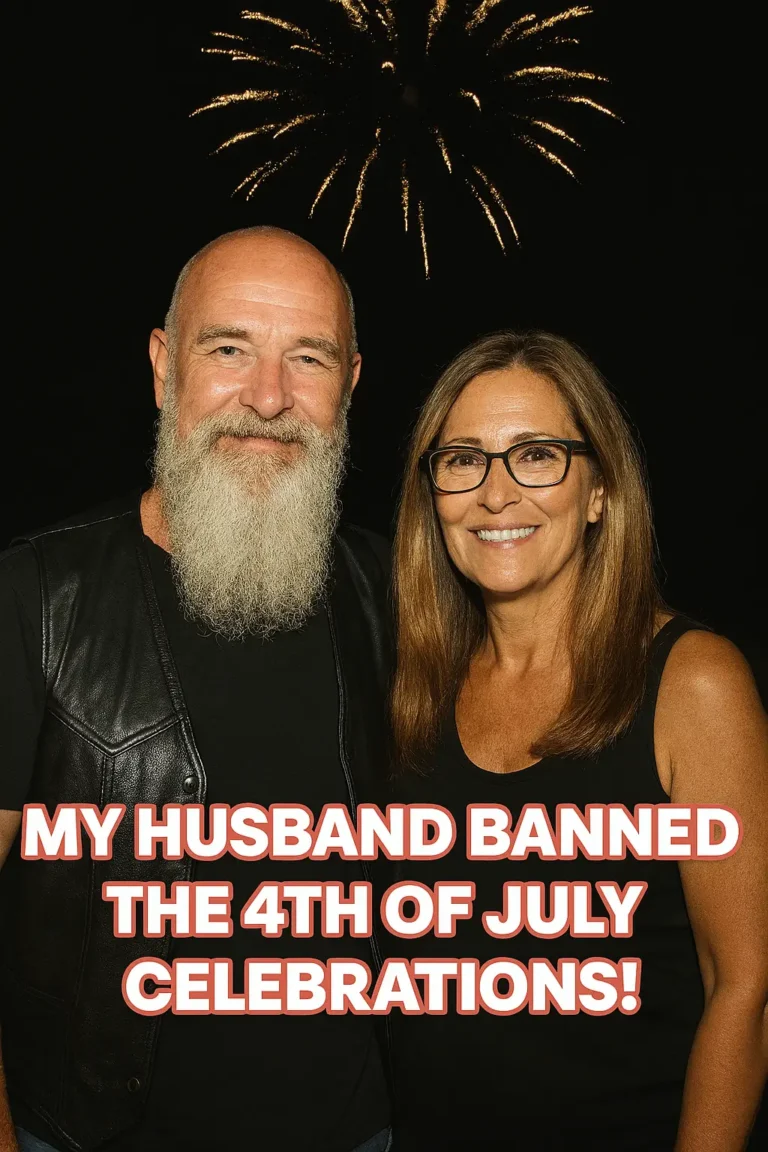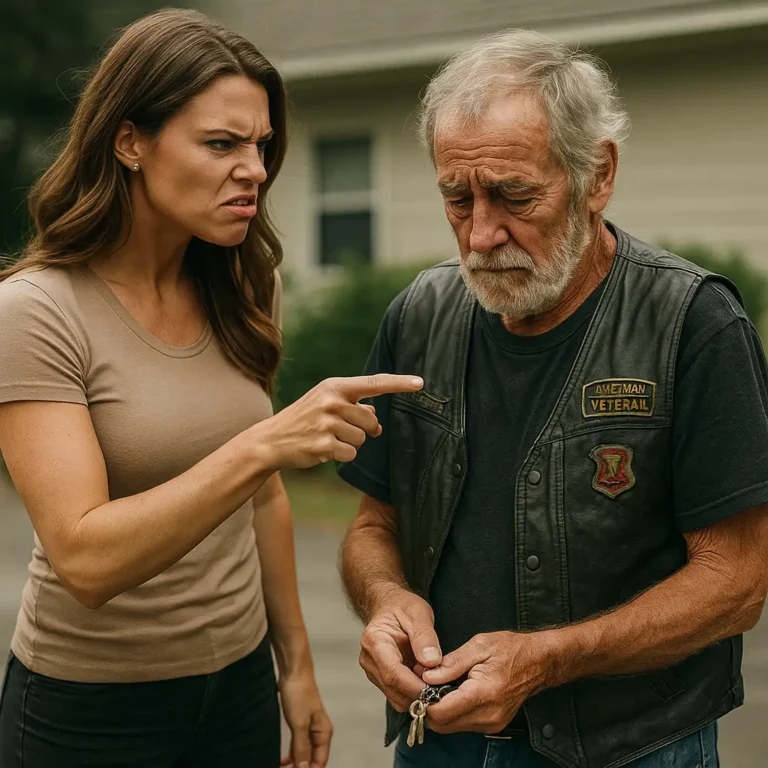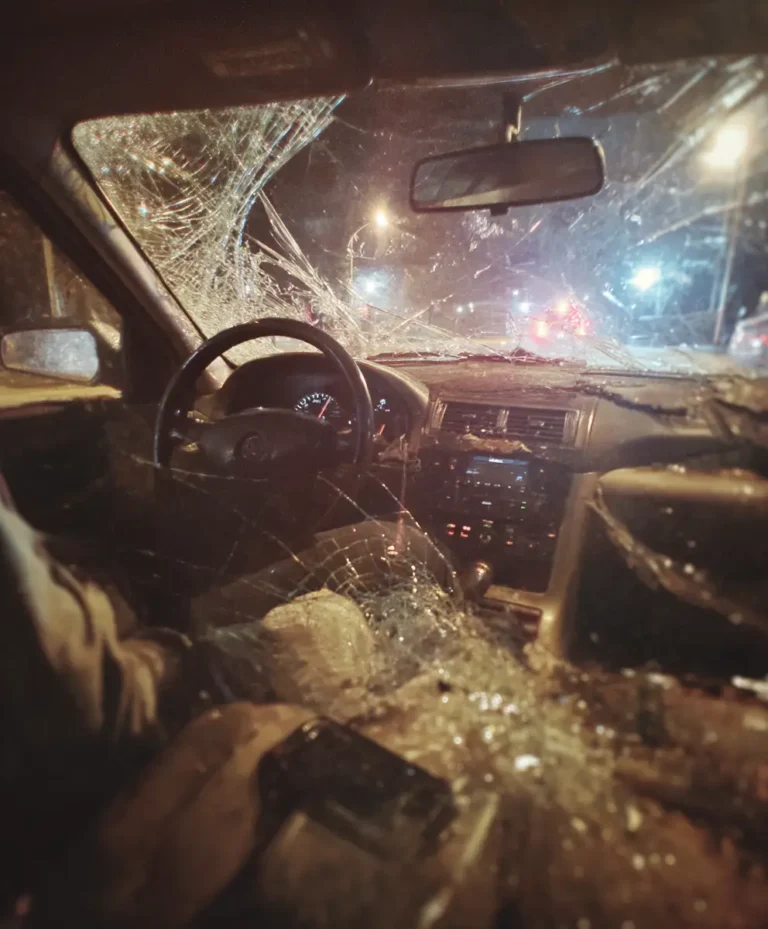Little autistic boy ran straight to the scariest-looking biker in the parking lot and grabbed his tattooed hand without saying a word.
I watched from my car as my son Noah – who hadn’t let anyone except me touch him in three years – pulled this massive bearded stranger toward the playground where six older kids were destroying his special routine.
Every day Noah arranged the wood chips in perfect patterns during recess, and every day these bullies kicked them apart while teachers claimed “kids will be kids.”
But today Noah had decided this random biker with skull rings and a leather vest covered in patches was his champion, and the poor man looked absolutely terrified of the small hand gripping his.
“Please fix it,” Noah said in his monotone voice, pointing at the scattered wood chips. “They ruined the pattern again.”
The biker – who looked like he ate danger for breakfast – knelt down to Noah’s eye level with surprising gentleness. “What’s your name, little man?”
“Noah. You smell like motorcycles and French fries. I like French fries.”
That’s when I should have run over, apologized, pulled my son away from the stranger. But something stopped me.
Maybe it was the way the biker didn’t flinch at Noah’s blunt observation, or how he waited patiently while Noah started his hand-flapping stim, or how his entire demeanor changed from intimidating to protective in seconds.
What this biker didn’t know was that Noah hadn’t spoken to any stranger in over a year. He didn’t know my son had been coming home crying every day for three months.
He didn’t know I’d begged the school to intervene, only to be told that Noah needed to “learn to cope with social challenges.”
But he was about to become part of something that would bring 200 bikers to an elementary school and change the way an entire community saw both autism and the men who ride motorcycles…
The biker’s name was Thor – “like the superhero,” he told Noah, which earned him the first smile I’d seen from my son in weeks.
“Thor fixes things,” Noah announced with absolute certainty. “Thor has tools.”
Thor looked at the destroyed wood chip pattern, then at the six boys laughing by the swings. They looked about eleven or twelve, that cruel age where empathy takes a backseat to popularity.
“Is this your special project?” Thor asked Noah.
“Fibonacci sequence,” Noah replied, already kneeling to show him. “It goes 1, 1, 2, 3, 5, 8. Nature’s pattern. But they always break it.”
I finally approached, my mother’s instinct overcoming my hesitation. “Noah, honey, you can’t just grab strangers—”
“You his mom?” Thor asked, standing up. He was even bigger up close, probably 6’3″, arms like tree trunks.
“Yes, I’m so sorry. He doesn’t usually approach people. He has autism and—”
“No need to apologize, ma’am.” Thor’s voice was surprisingly soft. “My nephew’s on the spectrum too. I get it.”
Noah tugged Thor’s hand again. “Fix it now, please. Recess ends in eighteen minutes.”
Thor looked at me, asking permission with his eyes. I found myself nodding.
What happened next was beautiful and heartbreaking at the same time.
Thor sat down right there in the wood chips, his massive frame folding into a cross-legged position. “Show me the pattern, Professor Noah. Teach me.”
For the next fifteen minutes, my son explained the Fibonacci sequence while Thor helped him arrange wood chips. Other parents started staring. Some pulled their kids closer. But Thor just focused on Noah, asking questions, following his precise instructions.
The bullies noticed too. They strutted over, confidence born from months of unchallenged cruelty.
“Hey, retard, who’s your babysitter?” the biggest one called out.
Thor’s entire body went rigid. But he didn’t stand, didn’t raise his voice. Instead, he kept working on the pattern while speaking loud enough for everyone to hear.
“You know what I love about motorcycles?” he said to Noah, ignoring the bullies. “They require precision. Every part has to work perfectly. Like your patterns.”
“Patterns are perfect,” Noah agreed. “People are not perfect. Except Mom. Mom is acceptable.”
Thor chuckled. The bullies moved closer.
“Excuse me, sir,” the ringleader’s voice dripped with fake politeness. “This retard is—”
Thor finally stood up. Slowly. Deliberately. The boys stepped back.
“That word,” Thor said quietly, “is unacceptable. This young man is an artist. A mathematician. And my friend.”
“You can’t threaten kids,” one boy said smugly. “My dad’s a lawyer.”
Thor smiled. It wasn’t a nice smile. “I’m not threatening anyone. I’m educating. See, Noah here understands patterns better than most adults. He sees beauty in order. You see weakness in difference. Which one of us is really limited?”
The principal, Mrs. Henderson, came rushing over. “Excuse me, sir, you can’t be on school property—”
“He’s my friend!” Noah shouted, something he never did. “Thor is fixing the pattern! He has permission!”
“Noah doesn’t have friends,” Mrs. Henderson said dismissively. “Sir, I need you to—”
“I’m his friend,” Thor repeated firmly. “Got a problem with that?”
I stepped forward. “He’s with us, Mrs. Henderson. My son invited him.”
She looked flustered. “Well, we have policies about strangers—”
“But no policies about bullying?” I found my voice suddenly sharp. “These boys destroy Noah’s patterns every day while you do nothing.”
“Kids will be—”
“Don’t,” Thor interrupted. “Don’t you dare say ‘kids will be kids.’ Kids will be what adults allow them to be.”
He pulled out his phone, made a quick call. “Yeah, bring everyone. Elementary school on Maple. Playground situation.”
Mrs. Henderson went pale. “You can’t bring a gang to—”
“Not a gang, ma’am. A motorcycle club. Of military veterans. Who really hate bullies.”
Within ten minutes, the rumble of motorcycles filled the air. Not just a few – dozens of them, pulling into the school parking lot in perfect formation. Parents grabbed their children. Teachers came out to stare.
But these weren’t the threatening criminals everyone expected. They were men and women in leather vests, yes, but vests covered in military patches, American flags, and “Support Autism Awareness” pins.
They parked and walked – didn’t swagger, just walked – to the playground where Noah was still working on his pattern, completely unfazed by the arrival of forty bikers.
“This the young professor?” a woman biker asked, her gray hair in a long braid.
“That’s Noah,” Thor confirmed. “He’s teaching us about Fibonacci sequences.”
What happened next was surreal. Forty-some bikers sat down in the wood chips and started helping Noah create his pattern. Some held chips in place. Others measured distances. A few started creating their own patterns based on Noah’s instructions.
The bullies had long since fled. Parents stood frozen, phones out, recording something they couldn’t quite believe. Teachers whispered among themselves.
But Noah? Noah was in heaven. He walked among the bikers, adjusting their work, explaining mathematical concepts, his usual anxiety completely absent.
“You’re doing it wrong,” he told a massive biker with face tattoos. “The spacing has to increase by the golden ratio.”
“Sorry, Professor,” the man said seriously. “Show me again?”
Mrs. Henderson tried to regain control. “This is highly irregular. I need all non-parents to leave immediately.”
“Actually,” a man in a suit stepped forward, “I’m Noah’s developmental pediatrician, Dr. Marcus Webb. Also a member of the Savage Angels MC. I’m very interested in how the school has been handling his accommodations.”
The principal’s face went from pale to red. “We follow all guidelines—”
“Really? Because allowing daily destruction of a therapeutic coping mechanism seems like a violation of his IEP.”
I hadn’t known Noah’s doctor rode motorcycles. The revelations kept coming.
“I’m State Representative Johnson,” another biker introduced himself. “Also interested in how our education funding is being utilized if bullying is considered acceptable.”
One by one, bikers revealed their day jobs – teachers, nurses, business owners, veterans, civil servants. The stereotype shattered with each introduction.
Then Noah did something that made everyone stop.
He walked to the center of the pattern, looked around at all the bikers helping him, and started to cry. Not a meltdown, not distressed tears, but quiet, grateful sobs.
“Nobody ever helped before,” he said simply.
Thor knelt beside him. “Well, now you’ve got about forty helpers. That okay with you, Professor?”
Noah nodded, wiping his nose on his sleeve. “Can you come every day?”
The bikers laughed, but it was warm, protective laughter.
“How about this,” Thor proposed. “We come every Friday. Help you build the best patterns this playground has ever seen.”
“Promise?” Noah’s voice was small.
“Bikers don’t break promises,” Thor said solemnly.
Mrs. Henderson tried one more time. “This is still a school matter—”
“Which is why,” Dr. Webb interrupted, “I’ll be filing a formal complaint about the failure to protect a vulnerable student. With documentation from…” he looked around, “about forty witnesses.”
The principal retreated.
The bullies never came near Noah again. But more importantly, every Friday for the rest of the school year, a group of bikers showed up to help Noah with his patterns. Rain or shine, they were there.
Other kids started joining in. Parents who’d pulled their children away from my “weird” son suddenly saw him differently. The boy who’d been labeled “retarded” was teaching grown men about mathematical sequences, and they were listening with genuine interest.
The most beautiful moment came six months later at Noah’s ninth birthday. I’d only invited family, knowing Noah didn’t have friends.
But at 2 PM, the rumble of motorcycles filled our street. Forty-three bikers pulled up to our house, each carrying a gift – pattern blocks, mathematics books, puzzles, and one very special present from Thor: a leather vest in Noah’s size with a patch that read “Professor Noah – Honorary Member.”
Noah wore that vest everywhere for months. To school, to therapy, to the grocery store. And whenever anyone stared or made comments, he’d announce proudly: “I’m a biker. Bikers help people.”
The bullying stopped completely. Not just for Noah, but throughout the school. It’s hard to pick on the “weird kid” when forty bikers consider him their professor.
Thor still visits regularly. He’s teaching Noah about motorcycle maintenance – “It’s all patterns and sequences,” he tells him. Noah is thriving in ways I never imagined possible.
And those bullies? One of them actually apologized last month. Came up to Noah with his mother and said he was sorry. Noah’s response was perfectly Noah: “Your apology follows appropriate social patterns. Accepted.”
The boy looked confused, but Thor translated: “He forgives you.”
That’s the thing about bikers that most people don’t understand. They see the leather, the tattoos, the loud motorcycles, and they see threat. They don’t see the veteran who still checks under cars for IEDs, finding peace only on his bike. They don’t see the abuse survivor who uses riding to reclaim control. They don’t see the fathers, mothers, grandparents who’ve learned that looking tough keeps the real monsters away.
They definitely don’t see forty grown adults sitting in wood chips, learning about Fibonacci sequences from an eight-year-old boy who needed champions and found an entire army.
Noah still arranges his patterns every recess. But now he’s not alone. Sometimes it’s Thor. Sometimes it’s another biker. Sometimes it’s just kids who learned that different doesn’t mean less.
And every time I see my son confidently explaining his patterns, wearing his honorary biker vest, surrounded by people who accept him exactly as he is, I think about that first day. When a desperate child grabbed a stranger’s hand and that stranger decided to be exactly who Noah needed him to be.
Not all heroes wear capes. Some wear leather vests and smell like motorcycles and French fries.
And sometimes, that’s exactly perfect.

